|
The First and the
Last: Horsing Around
Who conducted the last American mounted cavalry charge? A question
that any current or former member of the Regiment with even a
passing interest in its history, can easily answer; it was the 11th
ACR. Well - maybe, historians debate this and parse the answer. To
qualify, did it have to involve sabers and the call to charge with a
bugle? Do pistols and carbines count? How about mounted colonial
troops under American control?
You can see at least some of the debate here.
All of this tradition, heritage and discussion brought us to
thinking about horses, the Regiment and finally, the border. In the
Blackhorse, we had adopted so much related to the cavalry of 1870.
Swallow tail guidons, Stetsons and spurs, US cavalry brass belt
buckles on broad leather belts, ceremonial sabers brought out at
formal occasions, it’s a wonder no one was carrying the .45 caliber
Colt single action Army revolver. All of this wild west gear for a
unit that actually began in 1901, but when it comes to pomp and
circumstances, we will have no quibbling on dates and uniforms.
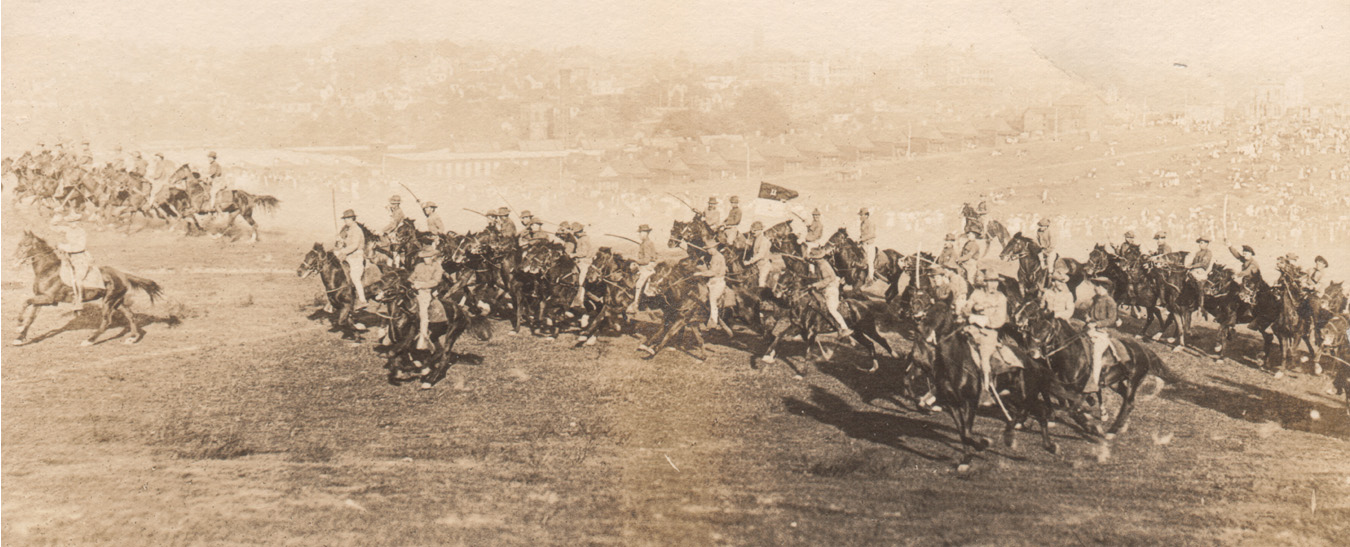 |
|
Only a few years after the creation of the 11th Cavalry, this great
image of a training charge. |
The Blackhorse has a long and interesting relationship with the real
horse. Where we went, many times, it went. Off to war, then
through peace and even to the border, Mexican and German. The
soldiers may not have looked exactly like Old Bill but that cavalry
trooper and his mount kept turning up in the most interesting
places.
Sunny California and
Dusty Mexico
The history of the 11th Cavalry begins at Fort Myer, VA in 1901.
Creation of the unit was part of an overall expansion of the Army
following the Spanish - American War. It was a cavalry regiment in
the most true use of the term, three squadrons and a HQ element, all
mounted.
In rapid course, the troopers and horses saw duty in the
Philippines, Cuba and along the restless Mexican border and it was
their familiarity with that region that led to participation in the
expedition led by General Pershing against Mexican revolutionary
Pancho Villa in 1916; full up mounted cavalry operations on and
across the border in the early 20th century. Now we’re talking
action in the saddle.
Here is the wiki.
Almost one hundred years ago but all of this saber and saddle is not
the long past history one might think. Although trucks and field
cars were muscling their way in, the 11th maintained a very active
horse cavalry tradition until the outbreak of World War II. In
1940, while stationed at the Presidio, Monterrey, and in California,
they were filmed conducting horse cavalry maneuvers.
Check this great video and frame pulls.
With the start of the war, however, the Blackhorse and the real
horse were soon to part, Allons had led to Adieu. In mid July,
1942, the Regiment was broken into subordinate units and then
redesignated as the 11th Armored Regiment and the 11th Tank Group.
For the armored units with some heritage link to the 11th Cavalry,
for the next few years, it was all gasoline and grease.
| |
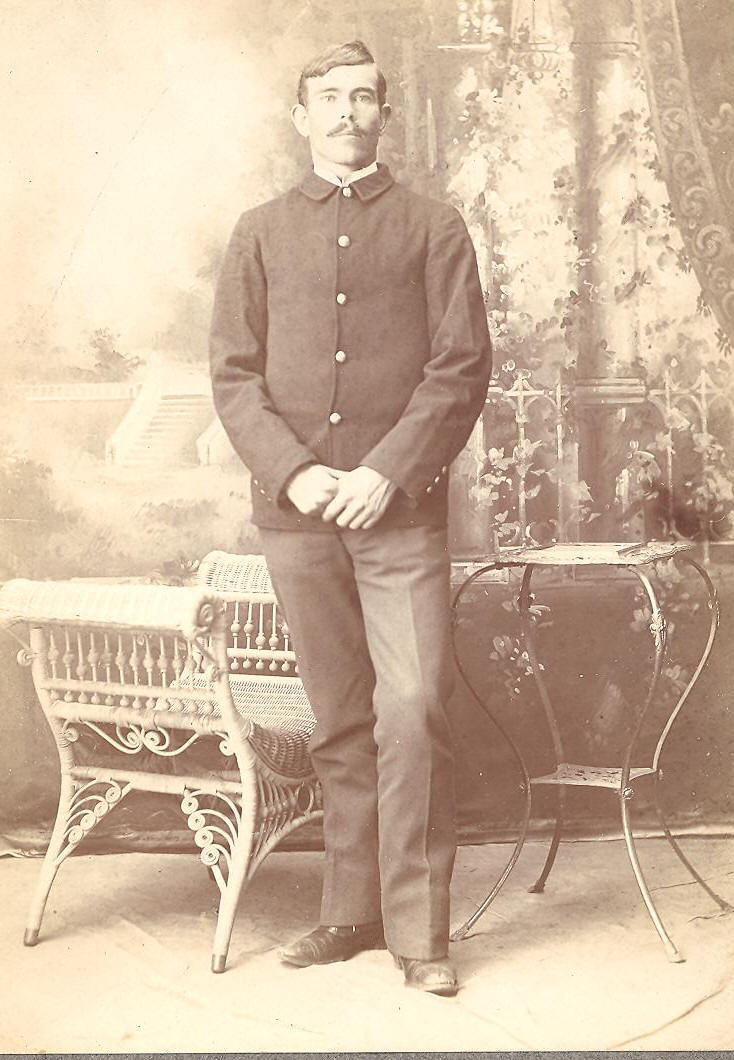 |
|
| |
Trooper William A Taylor, Troop H, 11th Cavalry in regular uniform,
1902. |
|
To many of us, World War II is beginning to seem like ancient
history but in that “ six degrees of separation “ vein, I am only
one step away from the Army and operational horse units. My father,
as a member of the Civilian - Military Training Corps, a program to
provide officer candidates some measure of military training just
prior to the outbreak of World War II, would recall his first formal
field training exercises in 1941. He was a Gun Section Cadet
Officer commanding three World War 1 vintage French 75 mm cannon.
Along with the cannon were three caissons for the ammunition and
twelve horses to pull the show down the trail.
Some months later, with the outbreak of the war, the old horses were
led away to their fate and the young cadets reported to Fort Hood
for OCS and tank destroyer training. He finished the war as a
Captain, the S2 of the 656th Tank Destroyer Battalion, attached to
the 9th Armored Division. Not a horse in sight.
Horses and mules, however, would play a role in the American Army
during the war. The sound of hoofs could be heard, particularly in
Italy where the mountainous terrain running the length of the
country often saw pack trains reminiscent of the Civil War supplying
advancing foot soldiers. Certainly not glorious but very necessary
work. On you mule skinners!
Searching for Horses
on the Border
The First -
This brings us to the post war period in Germany, the Constabulary,
the 11th Cavalry, the border and the last mission significant
contributions of American military horsemen. At their operational
high point, something in the vicinity of 200 troopers were assigned
to Constabulary horse platoons. The men spoke English, the horses
understood commands in German. Giddy - up! … Los! Vorwarts!
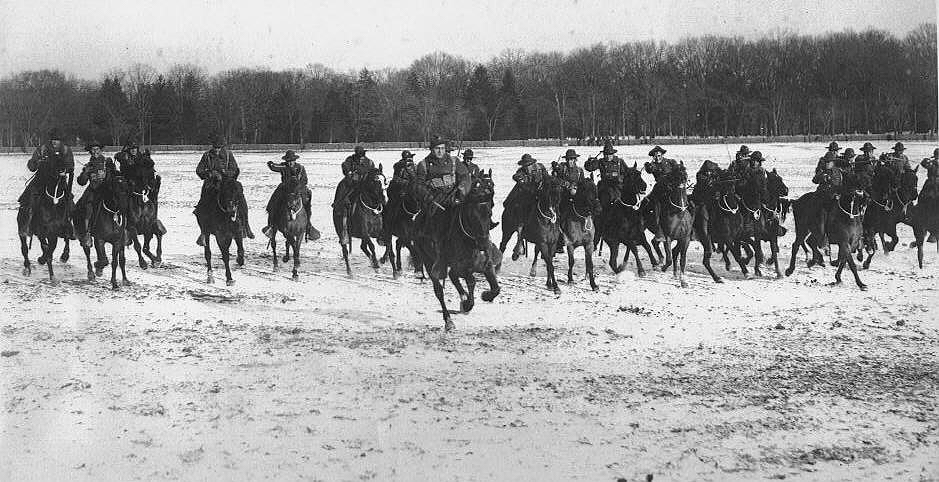 |
|
Cavalry charge maneuvers near Washington DC in late 1930s. |
The Constabulary forces were the bridge between the Army of
Occupation, basically all those forces in place when Germany
surrendered, and the 7th Army, configured to fight the Cold War.
This spans the period of 1946 - 1952. This interim force was
created for the most part, by taking existing units and
redesignating them into the Constabulary. These units operated
under new TO & Es, much of the heavy combat equipment was turned in,
as units drew jeeps, armored cars, motorcycles and even horses.
They were tasked with maintaining civil order as the German police
organizations were rebuilt, the control of smuggling/ suppression
of the black market, control of the border areas as the German Zoll
was rebuilt, and control of refugees.
| |
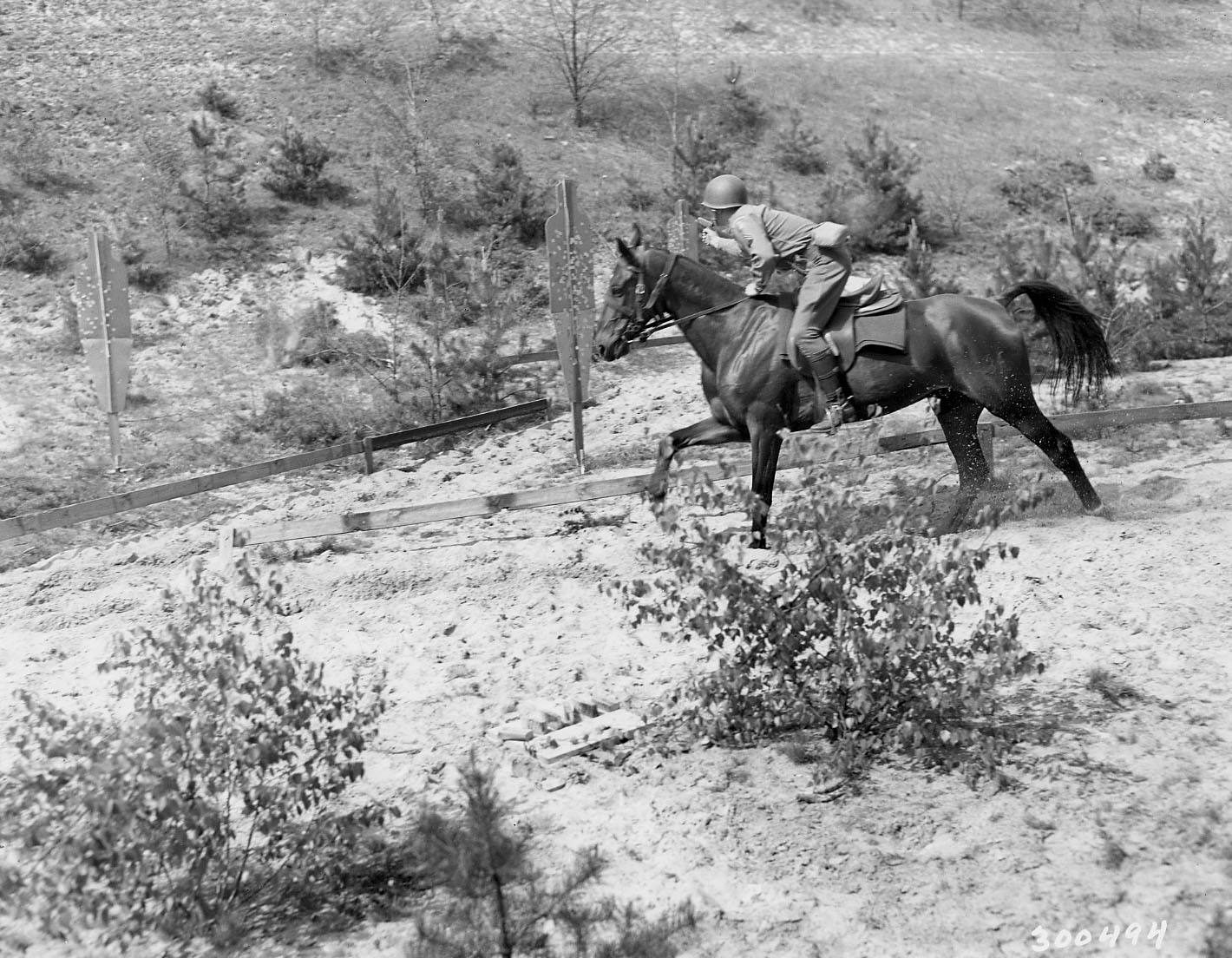 |
|
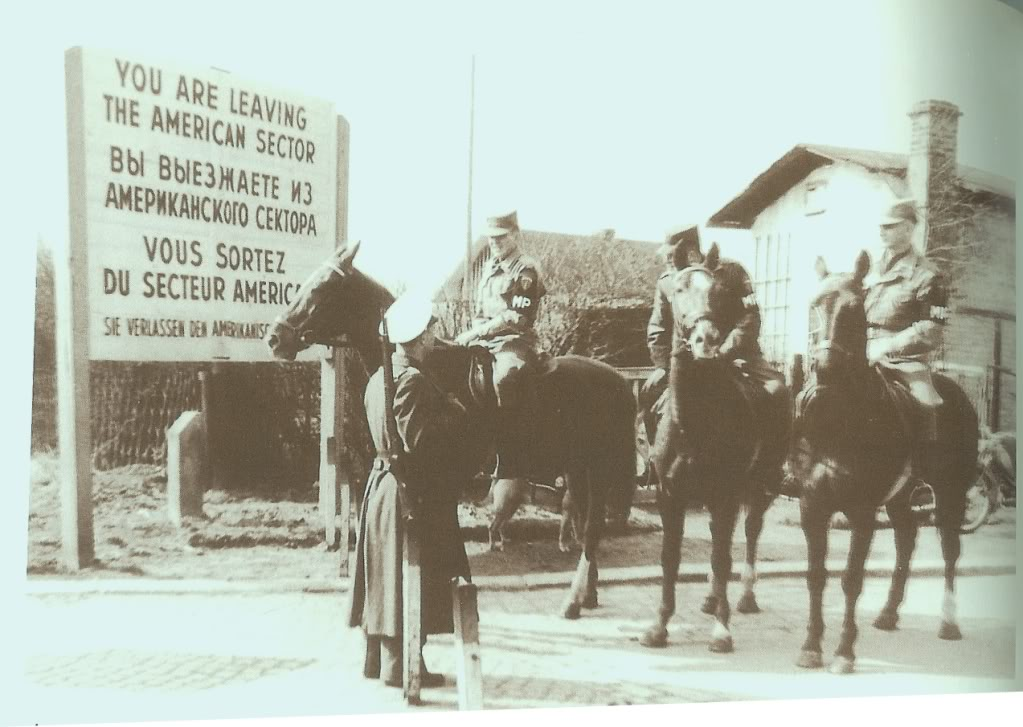 |
|
| |
Constabulary horsemen on a “ modified Table 8 “ - marksmanship on
horseback. |
|
Horsemen on the border in Berlin 1948. |
|
An excellent overview article on the history of the US Constabulary
in Germany extracted from Armor Magazine can be
found here.
In general organizational terms, the US Constabulary was divided
into three Brigades with multiple subordinate regiments and
squadrons. What Eaglehorse troopers might consider our part of
Bavaria was organized under the 1st Bde with HQ in Kassel. Then
heading south, located around Munich was the Second Bde and finally
the 3rd Bde with responsibility for a vast swath of southern
Germany. With dizzying speed, constabulary units were organized,
reorganized and redesgnated as areas of responsibility, command
boundaries and missions quickly changed.
Within the 2nd Bde area, the 11th Cavalry Group, one of the wartime
units that could trace its ancestry back to the 11th Cavalry of
Presidio days, was redesignated as the 11th Constabulary Regiment in
1946. It maintained its headquarters in Regensburg. With four
squadrons, the 11th then spread as far south as Passau and the
border between modern day Austria and the Czech Republic. To
facilitate patrols in the most rugged areas, particularly on the
border, many of the Constabulary Regiments to include the 11th, were
authorized one horse mounted platoon. This unit was then attached
to a subordinate squadron where patrol terrain was best suited to
horse and rider.
The horses came from European sources, the tack and riders from
America.
| |
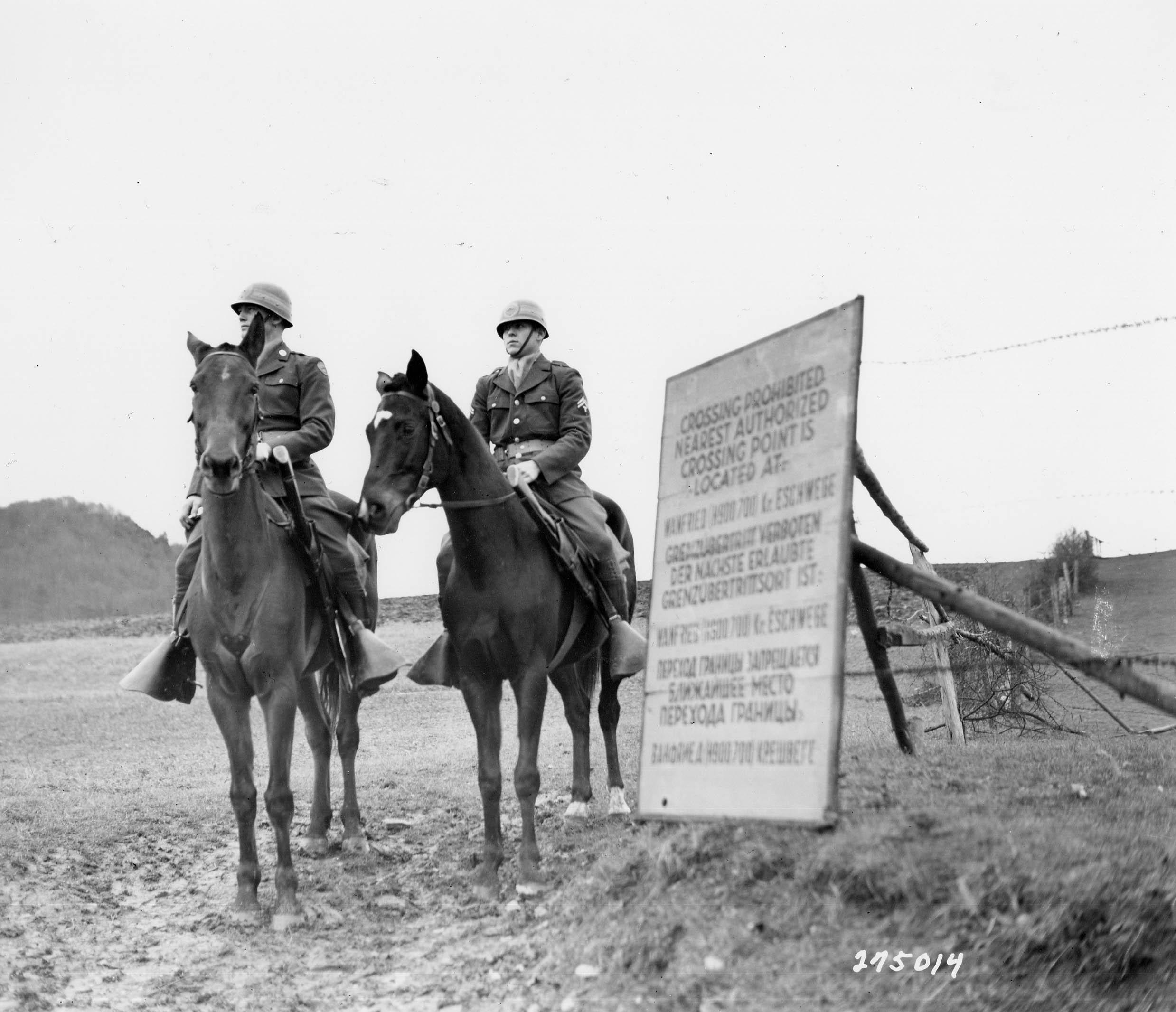 |
|
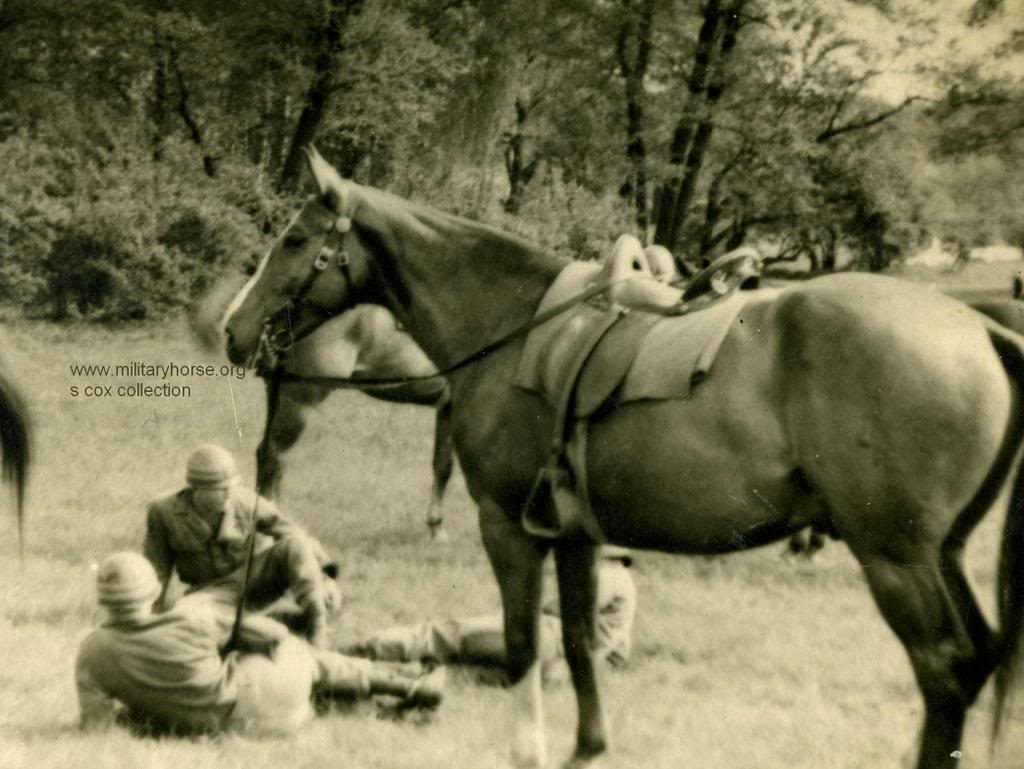 |
|
| |
|
|
Rest your mount, rest your butt. |
|
Operations of the Horse Platoon /11th Constabulary were briefly
mentioned in the Armored Cavalry Journal, May - June 1948. The
platoon had been split in half giving both the 8th Squadron and the
84th Squadron, patrolling on the Czech border, the ability to
traverse the most rugged areas. During one six month period, one of
these sections logged over 6000 miles of border patrol and was
instrumental in breaking up a major smuggling ring.
The exploits of other border horsemen were reported in Stars and
Strips.
The Jan 29, 1948 issue reported that the horse platoon of 6th
Constabulary Regiment, had logged over 9000 miles along the border
during the last quarter of 1947. Their area of responsibility ran
from Coburg south beyond Hof with the platoon base at the German
town of Rehau. Elsewhere in Germany, a few horse units were
assigned to selected Constabulary units distant from the border
including a ceremonial mounted platoon in the American sector of
Berlin and a few other platoons in select cities to assist in riot
control.
| |
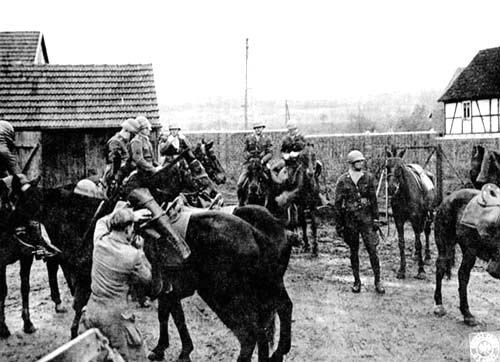 |
|
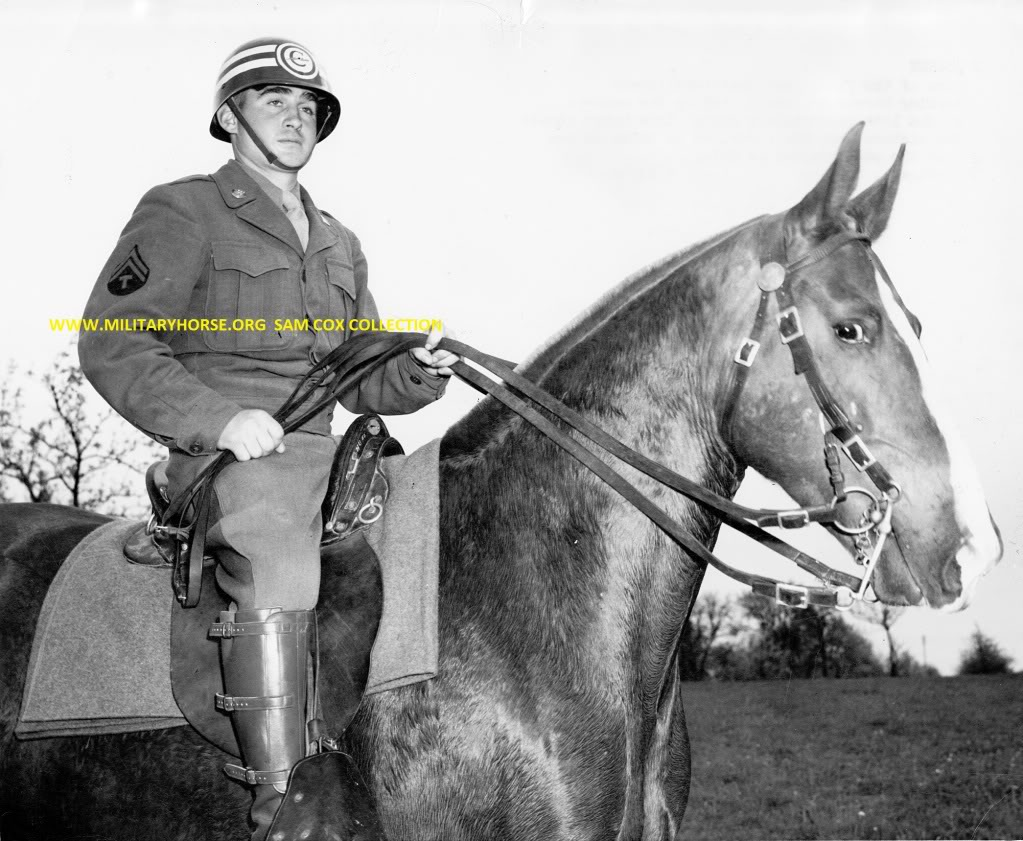 |
|
| |
Horse platoon somewhere in Germany. |
|
Looking very sharp. |
|
The 11th Regiment and the 6th Regiment conducted constabulary
operations for about two years before being disassembled. The 11th
HQ was deactivated in late Dec 1948 and the subordinate squadrons
either faced a similar fate or were redesignated to create the 6th
Armored Cavalry Regiment, a unit operating under the combat
equipment TO & E.
Interestingly, there is not much information related to horse
mounted activates in the Regiments of the 1st Bde, although now and
then, there is a brief mention.
The 14th Constabulary Regiment, HQ in Fritzlar, had responsibility
for the Hersfeld to Coburg border area and relieved the 6th
Constabulary Regiment when it was directed to return to a combat TO
& E. Drilling deeper into where units were stationed in what would
become the Eaglehorse border area many years later, can be
confusing. Individual Troops sometimes were stationed in areas for
only a few months before reassignment or consolidation. Here is a
snapshot of who was where as of early 1946.
The Armored Cavalry Journal for May - June 1948 reported that the
horsemen of the 14th were active in the border areas near Kassel
and Fulda, averaging about 100 miles per day.
| |
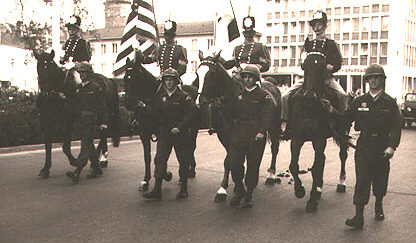 |
|
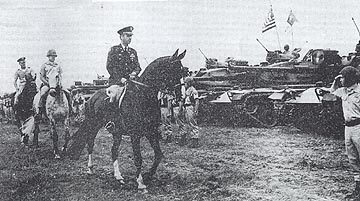 |
|
| |
Ceremonial horse section of the 2nd ACR parades through Bad
Kissingen in the mid 1960s when the 2/14 ACR was opcon to the 2nd
ACR. |
|
Late 1960s - unknown 14th ACR Regimental Commander passes before the
2nd Squadron at Bad Kissingen. |
|
To see a great graphic discussing dates and locations related to the
11th and 6th Constabulary Regiments put together by Walter Elkins at
his phenomenal web site discussing all things related to the history
of the Army in Germany before and during the Cold War,
go here.
This brings us back to the question, were there troopers on
horseback on / near the Eaglehorse border sector during the
Constabulary period? The honest answer and the best answer is
maybe. Perhaps riders from the 6th Constabulary horse platoon may
have ventured that far northwest along the border or the riders
stationed at Hersfeld may have patrolled east by southeast toward
Eussenhausen - there simply are no records.
Considering the high number of horse patrol miles logged, one cannot
imagine that the platoons were walking back and forth over the same
areas constantly. Also, the Regiments gave the horsemen wide
latitude to “ live off the land “ or drop in on other Constabulary
units for supplies. Considering the difficult terrain they normally
traversed and the distances involved, radio status reports were, at
best, problematic.
| |
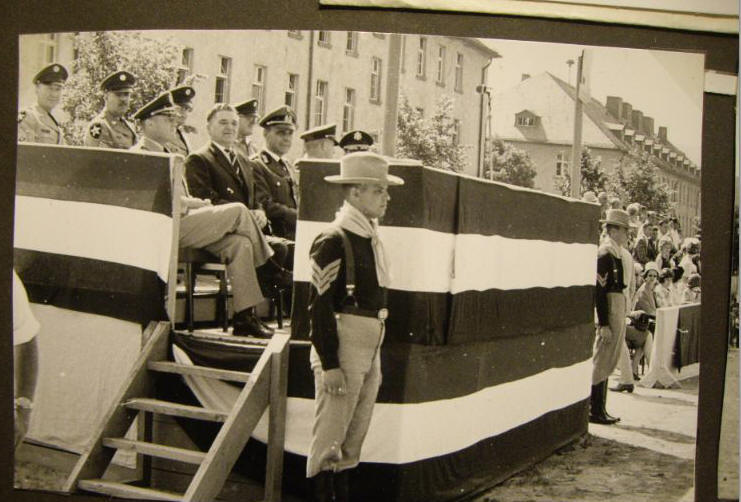 |
|
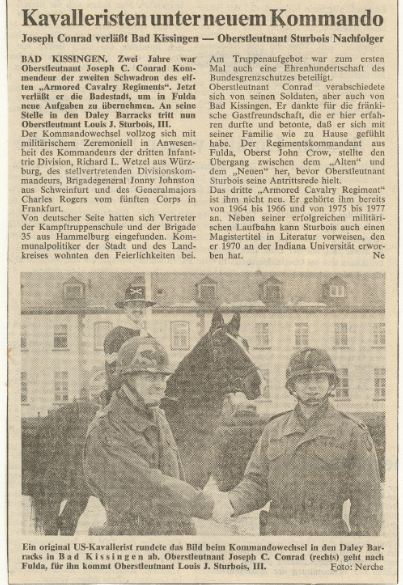 |
|
| |
Change of Command at Daley, mid 1960s. Roll out those 1870
uniforms. |
|
Eaglehorse Change of Command, early 1980s. In coming commander, LTC
Sturbois at left with departing commander, LTC Conrad. Mounted
trooper courtesy of Regt. |
|
It’s Good to be the
King
By the early 1950s, all of the dust begins to settle. The 14th
Constabulary is refitted to the combat unit configuration,
elsewhere, the last Constabulary units are phased out and border
observation responsibilities will be met thru fixed and temporary
observation points, jeep and dismounted patrols. Horse gear was
retuned to the US, no details surface as to the fate of the horses
but they had originally been purchased on the European market so it
is safe to assume that is how the stock was dissipated. But horses
and Americans still turn up now and then.
The adult daughters of Col ( ret ) James Spurrier recall a story
carried on in family lore. As battalion commander and ready to move
the 2nd Reconnaissance Battalion of the 14th Armored Cavalry from
Schweinfurt to Bad Kissingen, he drove over to meet the
Burgermeister and other town officials. Daley Barracks was still
sorting through housing issues and the commander was authorized to
find local accommodations. The Germans had learned that Spurrier
was a horseman of Olympic caliber and were eager to impress the new
garrison commander.
He was taken to see a large home that was available for rent and
then inspect the local stables where he could quarter horses he was
bringing from Schweinfurt. At the end of the day, certain they had
pleased the American commander, they stood by as he entered his
sedan. Spurrier rolled down the window and proclaimed the family
quarters were adequate and the stable was sub par, alternatives for
the horses needed to be quickly found. He then drove away.
While assigned to Daley, LTC Spurrier and his wife took their horses
out whenever possible.
| |
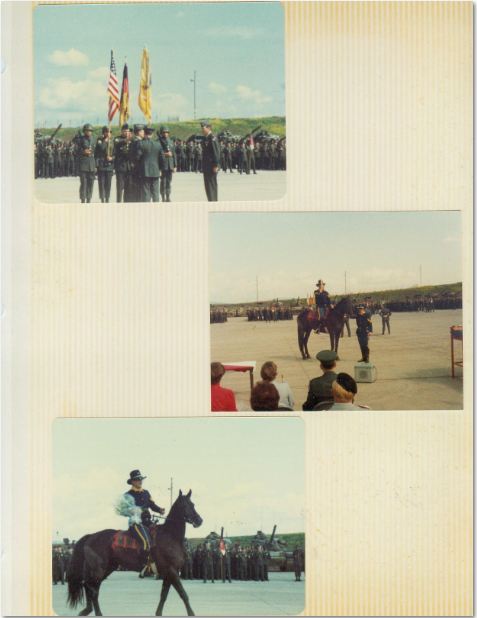 |
|
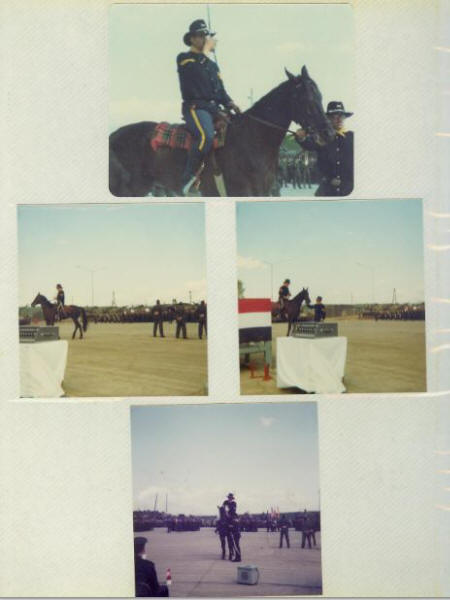 |
|
| |
LTC Clarke Change of Command in mid 1980s. Fetch the horses! |
|
|
|
Over the following years, other commanders seem to have had horse
sense as well. Looking back thru the photo archives, troopers in
1870s cavalry garb as well as horses appear at both 14th ACR and
Blackhorse squadron and battalion changes of command. When you want
a show, roll out the horses.
And the Last -
Retired CSM Richard E. Morgan recalls this great story from his
period as Troop G First Sergeant in the mid 1980s. I believe we can
say without contradiction that he participated in the final horse
mounted patrol on the German border. It took a long time to close
that loop.
In his words:
This photograph was snapped at checkpoint 132 on the East West
German Border in May 1985. We rented the horses. An officer who was
on the rodeo team of Texas A & Am led it. The troops insisted I ride
part of the patrol and get my picture taken though I did not want to
do so. However, I did ride when the LT complained of a sore butt as
he had not ridden for several years. Of course, it was quite a few
more years for me.
The potential for harm was great in that a spooked horse or a stray
shot by an East German or a squawking radio could have set one of
them off and into the minefield. Discretion was the better part of
valor for our field grades on that day.
It was a beautiful day in Germany. I insured the horses using an
Inland Marine Policy through a local German guy I knew and he
re-insured the horses with Lloyds of London. During the patrol we
garnered more interest from the Russians and the East Germans than
we did from the Americans. The little black mare I rode was feisty
and a lot of fun as well as a good runner and fence jumper. I backed
her up until she did a Trigger movie trick up on her hind legs with
front hooves pawing the air. I then rode right at the MI-26 Russian
Hind Helo. Of course, the Hind is immune to any fire smaller than a
23 mm cannon and the crew was having the time of their lives taking
pictures of the Americans on horseback.
It was a normal patrol in that we sent up reports through our
various headquarters as US Horse Patrol as opposed to US Foot or US
Jeep Patrols. However, we were accompanied by East German TV crews
almost all of the way. We were denied the use of 1870′s period
uniforms from the museum as that would considered a change of
uniform and there was not time to get permission from the Tripartite
Commission. I know that sounds like a bit of fluff but wars in
Europe have been known to start over false incidents on borders by
imposters in uniform such as the Germans caused in their invasion of
Poland 1939.
| |
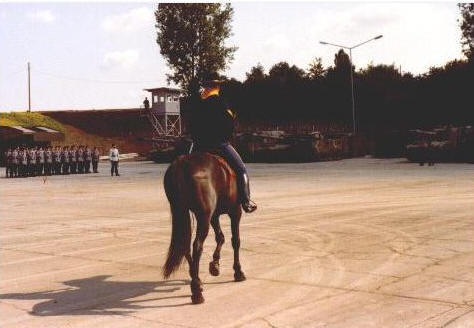 |
|
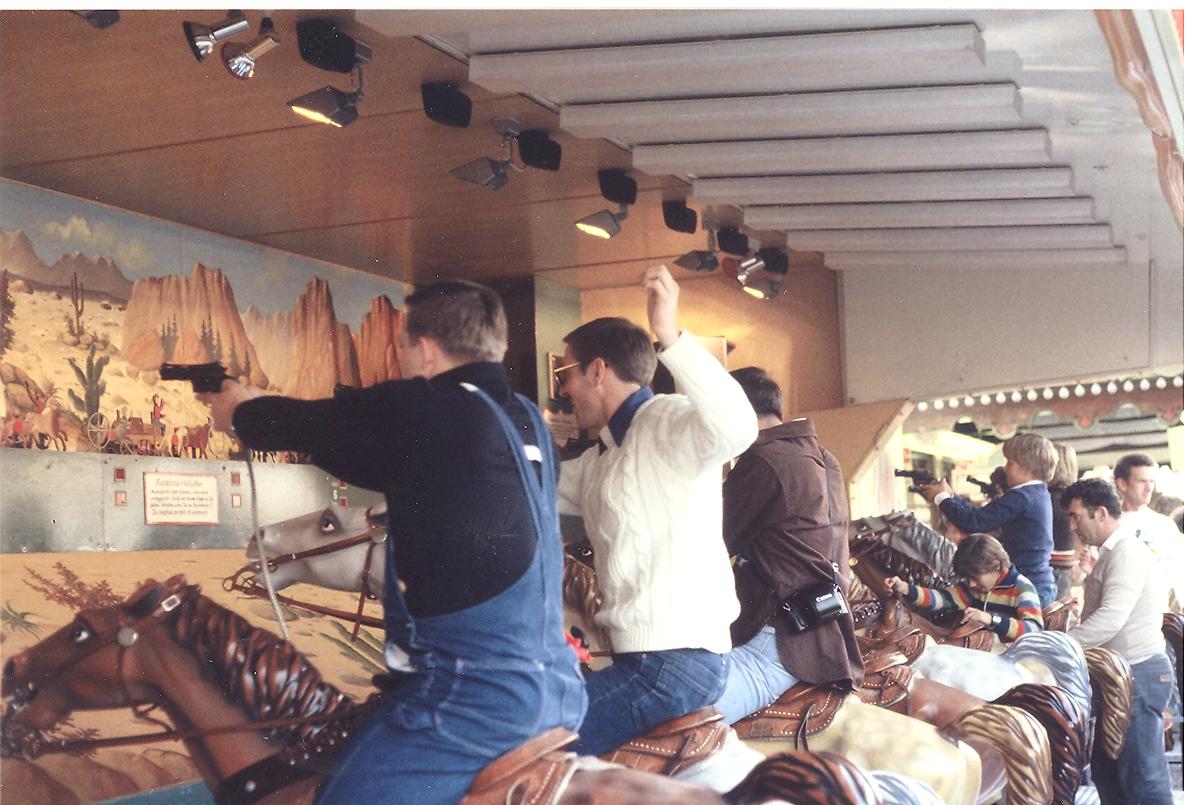 |
|
| |
|
|
But this dream of returning horse mounted patrols to the border was
an idea that was forever alive. Lt Mathis and Lt Waldrop spent
endless hours on simulators in the early 1980s conducting Proof of
Concept tests. |
|
We did a total of 16 miles on the horses with me doing about 9
miles. None of we modern Cavalrymen could walk without limping and
whining the next day. After that ride, I knew where the term hard
ass first got started. Of course, we used about ten different
riders, several of whom brought their own tack. Everyone who made
the ride thought it was the time of their life.
The attached picture became an icon in my Cavalry Troop and in my
family life. It is also a treasure of the Bundesgrenzschutz Company
that was our German Partnership unit. All of the Germans love horses
and were very happy we did the horse patrol. Every little village
brought the ponies veggies and apples. I was glad none of them got
colicky.
I was also glad when the day ended as it was nerve racking to be the
guy in charge of an event with some much potential for a bad ending.
But again, a lot of people talk smack about doing a horse patrol on
the Border but there are damn few that can make it happen. My guys
said, “In G Troop we don’t just talk about it, we do it.”
| |
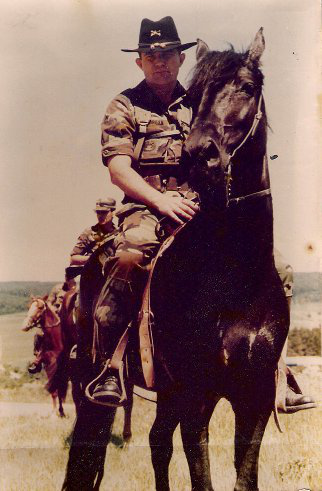 |
|
| |
Our best day - First Sergeant Richard E. Morgan stamps new prints
into old border trails. |
|
Dec 2012 |